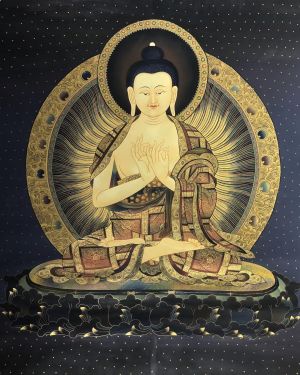GURU AND ŚIṢYA
HE Guru is the religious teacher and spiritual guide to whose direction orthodox Hindus of all divisions of worshippers submit themselves. There is in reality but one Guru. The ordinary human Guru is but the manifestation on the phenomenal plane of the Ādināthā Mahākāla, the Supreme Guru abiding in Kailāsa.1 He it is who enters into and speaks with the voice of the earthly
Guru at the time of giving mantra. Guru is the root (mūla) of dikṣ a (initiation). Dikṣ a is the root of mantra. Mantra is the root of Devatā; and Devatā is the root of siddhi. The Munda-mālā-Tantra says that mantra is born of Guru and Devatā of mantra, so that the Guru occupies the position of a grandfather to the Iṣṭa-devatā.
It is the Guru who initiates and helps, and the relationship between him and the disciple (śiṣ ya) continues until the attainment of monistic siddhi. Manu says: “Of him who gives natural birth and of him who gives knowledge of the Veda, the giver of sacred knowledge is the more venerable father. Since second or divine birth insures life to the twice-born in this world and the next.” The Śāstra is, indeed, full of the greatness of of Guru.3 The guru is not to be thought of as a mere man. There
̣1 Guru sthānam hi kailāsam (Yoginī-Tantra, chap. i).
2 Mantra-pradāna-kāle hi mānuṣ e naga-nandini, ̣ ̣ Adhisthānam bhavet tatra mahākālasya śamkari, ̣ Atastu gurutā devī mānuṣ e nātra sa mśayah. (ibid.)
3 See chap. i of the Tantra-sāra, which also deals with the qualities of the Guru; the relationship between him and the disciple, qualities of the disciple and so forth. is no difference between Guru, mantra, and Deva. Guru is father, mother, and Brahman. Guru, it is said, can save from the wrath of Śiva but none can save from the wrath of the Guru. Attached to this greatness there is however,
responsibility; for the sins of the disciple recoil upon him. Three lines of Gurus are worshipped; heavenly (divyānga), siddha (siddhānga), and human (mānavanga). The Kula-gurus are four in number, viz.: the Guru, Parama-guru, Parāpara-guru, Parameṣ ṭ iguru; each of these being the guru of the preceding one. According to the Tantra, a woman with the necessary qualifications may be a guru,
and give initiation.2 Good qualities are required in the disciple, and according to the Sāra-samgraha a guru should examine and test the intending disciple for a year. The qualifications of a good disciple are stated to be good birth, purity of soul (śuddhātmā),
and capacity for enjoyment, combined with desire for liberation (puru-ṣ ārtha-parāyaṇ ah). Those who are lewd (kāmuka), adulterous (paradārātura), constantly addicted to sin (sadā pāpa-kriya), ignorant, slothful and devoid of religion, should be rejected. The perfect sādhāka who is entitled to the knowledge of all Śāstras is he who is pure-minded, whose senses are controlled (jitendriyah), who is ever engaged in doing good to all beings, free from false notions of
GURU AND ŚIṢYA
A dualism, attached to the speaking of, taking shelter with and living in, the supreme unity of the Brahman. So long as Śakti is not fully communicated (see next page) to the śiṣ ya’s body from that of the guru, so long the conventional relation of guru and śiṣ ya exists. A man is śiṣ ya only so long as he is sādhaka. When, however, siddhi is attained, both Guru and Śiṣ ya are above this dualism. With the attainment of pure monism, naturally this relation, as all others, disappears.
